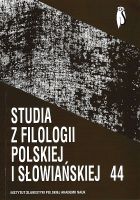Serbskie językoznawstwo diachroniczne na początku XXI wieku
Serbian diachronic linguistics at the beginning of the 21st century
Author(s): Tomasz KwokaSubject(s): Language and Literature Studies
Published by: Instytut Slawistyki Polskiej Akademii Nauk
Keywords: Serbian diachronic linguistics
Summary/Abstract: The article provides information on bibliographical data illustrating the condition of research in Serbian diachronic linguistics at the beginning of the 21st century. During this period, three phenomena deserve particular attention. The first one are re‑editions of fundamental theoretical works by Serbian linguists. The second one involves the attempts to familiarize the Serbian reader with works by foreign authors which are usually hardly accessible in Serbia (books by Nikita Tolstoy, Joseph Schütz, Emile Benveniste’s dictionary). Serbian translation of Ivan Popović’s Geschichte der Serbokroatischen Sprache (The History of the Serbo‑Croatian Language), originally written in the German, gives readers a chance to get acquainted with this version of the book which had previously been known only from a small paper published in Novi Sad in 1955. The last important element of Serbian diachronic linguistics are two large lexicographic projects (etymological dictionary and the dictionary of Serbian editing of the Church Slavonic language). The research of Serbian linguists focuses primarily on the works from the period of Middle Ages and the processes which accompanied the development of contemporary Serbian language at the turn of 18th and 19th centuries.
Journal: Studia z Filologii Polskiej i Słowiańskiej
- Issue Year: 2009
- Issue No: 44
- Page Range: 237-258
- Page Count: 22
- Language: Polish

